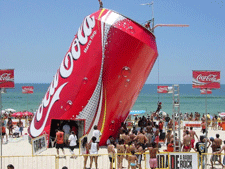Event Budgets Up, Time for a Refresher Course
Event marketing budgets are expected to grow about 8% this year, with marketers putting added pressure on the experiences to produce quality leads, metrics and plenty of sharing through social media. As an example, HGTV has sidestepped TV, print and outdoor in favor of a splashy calendar of events as a way to reach people one-on-one to make sure they are aware that its stable of products goes way beyond the popular “House Hunters” TV show to interior paint, furniture and other consumer products.
 That nearly 8% growth is more than double last year’s rate of 3.6%, according to the EventTrack 2012 study from the Event Marketing Institute. With that in mind, industry experts share a refresher on best practices and tips to get your events off and running.
That nearly 8% growth is more than double last year’s rate of 3.6%, according to the EventTrack 2012 study from the Event Marketing Institute. With that in mind, industry experts share a refresher on best practices and tips to get your events off and running.
Prior to the event
1. Set up a Facebook page and Twitter feed to post on a regular basis details about the upcoming event. Use social media platforms with proven track records. Now is not the time to try something new.
“Integrating existing social media platforms that are already to scale—and getting massive PR and a high awareness of buzz—get people to share your stuff,” Ian Wolfman, chief marketing officer at imc2, said. “Don’t pick the platforms that are new or struggling. Pick the ones that will help drag your brand into scale. Don’t push a bolder up a hill instead of standing in the flow of consumer behavior.”
2. Develop relationships with relevant bloggers who can write about the event or stage events for you. Crocs footwear recently upgraded its blogger program with five well-followed bloggers who are the first to hear about and see new styles that they preview to their followers. They will also participate in experiential events throughout the year to showcase new seasonal collections.
3. Create flyers, banners and handouts that include the Twitter handle, Facebook URL or other social platforms or websites to distribute onsite.
4. Develop a social media checklist/content calendar for the event staff to use during the event.
5. Design a media plan. Press coverage was one of the primary tracking metrics cited in the EventTrack study in addition to total attendance and leads gathered.
6. Set goals and establish metrics. Some 69% of brands reported that the absence of an industry standard ROI measurement model is a challenge for their organization. Brands with large event budgets are most likely to track gross sales related to their event programs as well as customer and attendee time spent at their events. Large and mid-sized firms are also more likely to track press coverage and related Facebook activity resulting from their events.
“In experiential, social provides metrics,” said Emily Duban, executive vice president of strategy and growth, at Becore, which ranked No. 86 on the 2012 PROMO 100. “That’s very important for us to be able to ground our work in a new metric.”
At the event
1. Create onsite communities by asking visitors to check in on their own personal devices or supply a tablet or other device for attendees to use
2. Collect consumer data through contest registrations, email signups or other means.
“We’re finding we’re able to gather information through a personal touch point. When you’re engaged in a dialog with somebody they are more than happy to share and provide information,” said Mercedita Roxas-Murray, executive vice president of strategy and brand planning at RedPeg, a 2012 PROMO 100 agency.
3. Provide a location to take photos that can be loaded to Facebook and Twitter and shared.
“We know based on the number of people who participate that the dialog happens,” Roxas-Murray said. “So it’s not just, I spent three seconds and took my photo and posted it, but that qualitatively they are participating.”
4. Post content throughout the event to encourage people to stop by or share that content.
Nearly eight out of 10 of the event participants in the EventTrack study told a friend or family member about their event experience. Most of the consumers described the event experience in person. And half of event participants told their family or friends about the experience either during the event or the same day.
5. Ask for interaction, suggestions and feedback through posts, contests or other interactive programs to drive specific actions and user-generated content related to the event.
6. Allow visitors to participate in the event using onsite social media platforms. People under 35 are more likely to text about their experiences or post information on a social media site, the study found.
Social enables people to engage about what’s happening on site with the outside world,” Roxas-Murray says. “For us it’s about what is the experiential design of the interaction. How do we get the consumer to immerse in the brand so they walk away feeling something about it."




























